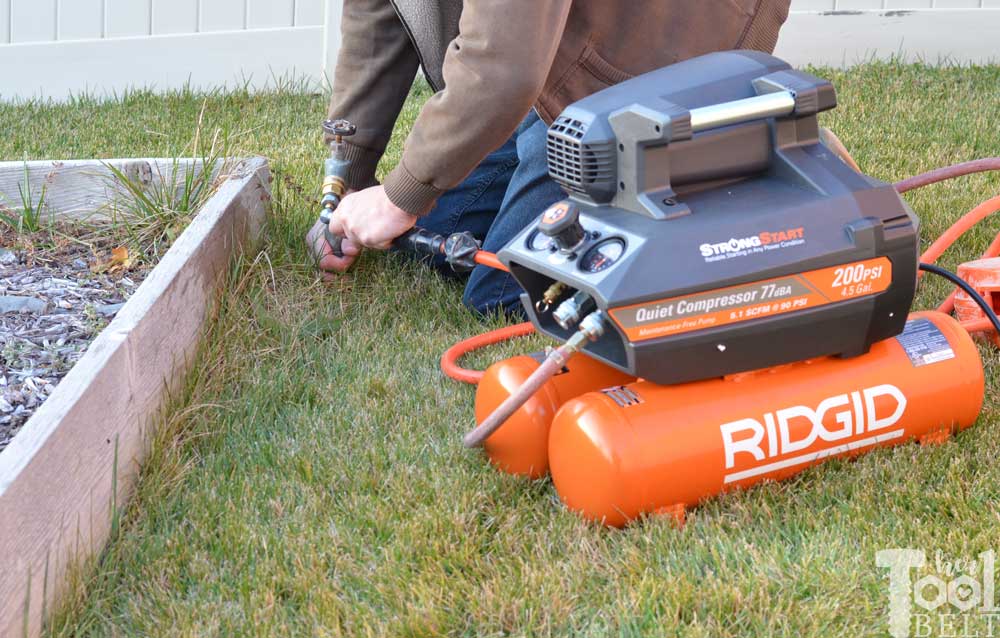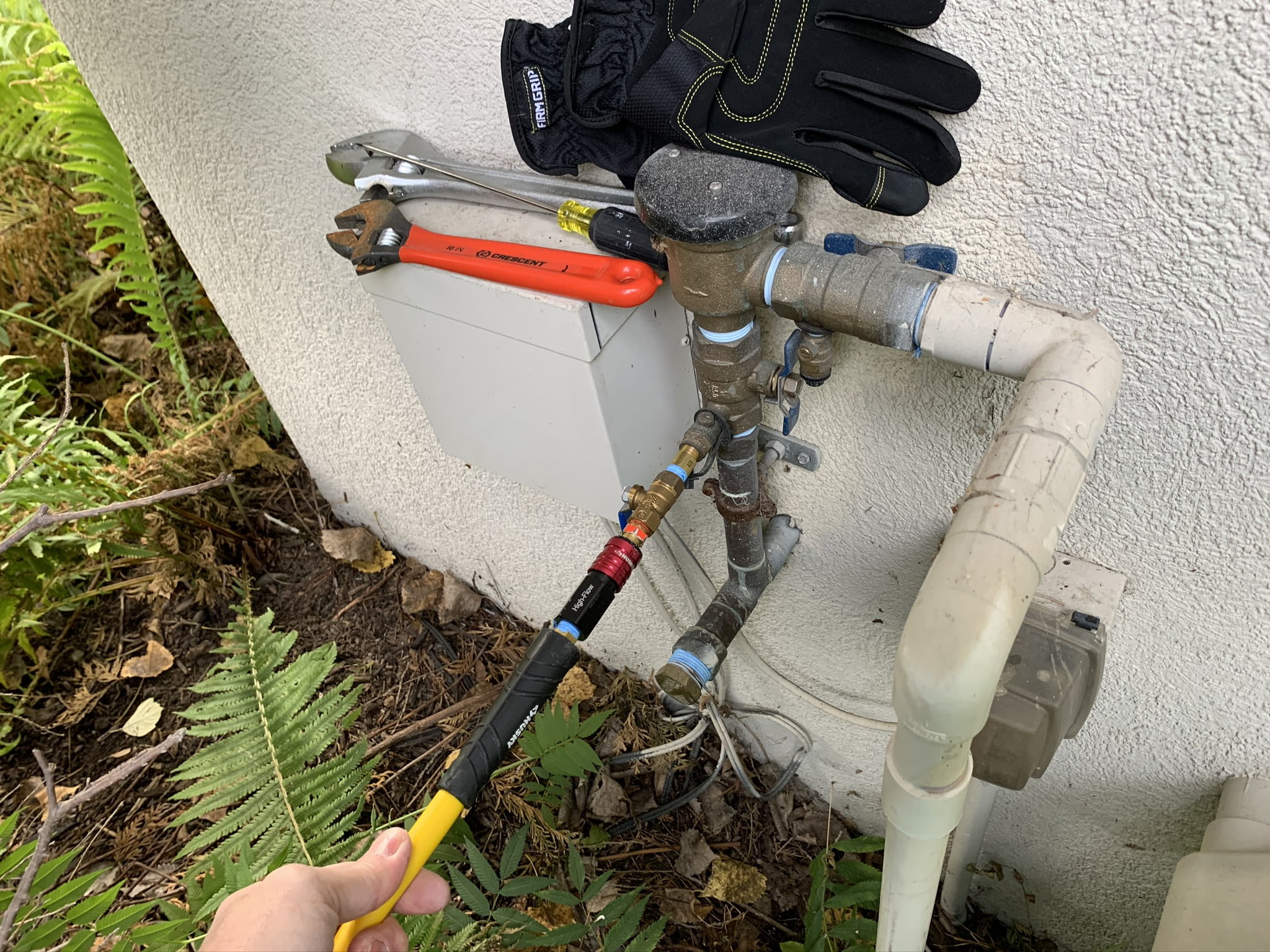Steps to winterize sprinklers using an air compressor: Shut off the water supply, then blow out the system with compressed air. Ensure each zone is thoroughly cleared of water.
Winterizing your sprinklers is crucial to prevent damage from freezing temperatures. An air compressor effectively clears out residual water from the system. This process helps avoid costly repairs and keeps your irrigation system in top condition. Proper winterization ensures your sprinklers are ready for use when warmer weather returns.
Follow these steps to protect your investment and maintain the longevity of your irrigation setup. The process is straightforward and can be done with some basic equipment and precautions. Always prioritize safety while handling air compressors and sprinkler systems.
Gather Necessary Tools
Winterizing your sprinklers is a crucial step to prevent damage. Start by gathering the necessary tools. Having the right equipment makes the job easier and more efficient.
Air Compressor Specifications
Choose an air compressor with at least 50 cubic feet per minute (CFM). A higher CFM ensures better performance. It should also have a pressure rating of 50-80 PSI. This helps to clear the water from the sprinkler lines effectively.
| Specification | Recommended Value |
|---|---|
| CFM (Cubic Feet per Minute) | 50 CFM or more |
| PSI (Pounds per Square Inch) | 50-80 PSI |
Additional Equipment Needed
Besides the air compressor, you need other tools:
- Air hose: Connects the compressor to the sprinkler system.
- Quick-connect coupling: Ensures a secure connection.
- Safety goggles: Protect your eyes during the process.
- Gloves: Keep your hands safe and clean.
- Pressure regulator: Controls the air pressure.
Gathering these tools ensures a smooth and efficient winterizing process.

Prepare The Sprinkler System
Getting your sprinkler system ready for winter is crucial. This process helps prevent damage and ensures a smooth start in spring. The first step is to prepare the sprinkler system properly. This involves turning off the water supply and draining the remaining water.
Turn Off The Water Supply
Start by locating the main water valve for your sprinkler system. The valve is usually near your water meter or in a basement. Turn the valve clockwise to shut off the water supply. This step prevents any new water from entering the system.
Next, locate the backflow preventer. This device stops contaminated water from entering your home’s water supply. Turn off the valves on the backflow preventer to ensure water flow is completely stopped.
Drain Remaining Water
Draining the remaining water is essential to avoid frozen pipes. First, open all manual drain valves to release trapped water. You might find these valves at low points in your system.
For systems with automatic drain valves, activate them by turning on a sprinkler zone. This will release water from the pipes. You may need to activate each zone manually to ensure all water is drained.
Using an air compressor can help remove any remaining water. Connect the air compressor to the blowout port on your system. Set the compressor to a low pressure, around 50 PSI, to avoid damaging the pipes.
Run the air compressor for each zone until only air comes out. This ensures all water is expelled from the system.
| Step | Action |
|---|---|
| 1 | Turn off the main water valve |
| 2 | Turn off the backflow preventer valves |
| 3 | Open manual drain valves |
Connect The Air Compressor
Winterizing your sprinkler system is essential to avoid damage from freezing temperatures. Connecting the air compressor is a crucial step in this process. Follow these steps to ensure your system remains in top condition throughout the winter months.
Choose The Right Connection Point
First, identify the appropriate connection point on your sprinkler system. This is usually a blowout port or a quick-connect fitting. The location may vary depending on your sprinkler system model.
Refer to your sprinkler system manual to find the exact connection point. This ensures the air compressor connects to the right spot for effective winterization.
Secure The Connection
Once you have identified the connection point, attach the air compressor hose. Ensure the connection is snug and secure to prevent air leaks.
Use a wrench to tighten any fittings if necessary. This will help maintain a strong seal and ensure an efficient blowout process.
Double-check the connection to make sure there are no gaps or loose fittings. A secure connection is critical to properly winterizing your sprinkler system.

Blow Out The Sprinkler Lines
Blowing out the sprinkler lines is crucial for winterizing your system. Water left in the pipes can freeze and cause damage. Using an air compressor is an effective method to ensure all water is removed.
Set Compressor Pressure
First, set the air compressor to the correct pressure. The ideal pressure is between 50 to 80 PSI. Too much pressure can harm your sprinkler system. Refer to your sprinkler’s manual for specific pressure settings.
Sequentially Blow Out Zones
Blow out each sprinkler zone one at a time. Follow these steps:
- Attach the air compressor to the blowout port on the sprinkler system.
- Turn off the water supply to the sprinkler system.
- Open the manual drain valve if your system has one.
- Activate the first sprinkler zone using the controller.
- Turn on the air compressor and let it run until no water comes out of the sprinklers.
- Turn off the air compressor and move to the next zone.
Repeat these steps for each zone in the sprinkler system. Ensure each zone is completely free of water.
Here is a table summarizing the steps:
| Step | Action |
|---|---|
| 1 | Attach air compressor to blowout port |
| 2 | Turn off water supply |
| 3 | Open manual drain valve |
| 4 | Activate first sprinkler zone |
| 5 | Turn on air compressor |
| 6 | Turn off air compressor and move to next zone |
Blow out all the zones to ensure no water remains. This step is crucial for preventing freeze damage in winter.
Inspect And Repeat
Winterizing your sprinkler system is crucial to prevent damage from freezing. After blowing out the water with an air compressor, the next step is to inspect and repeat to ensure complete removal of water. This step ensures your sprinkler system is winter-ready and protected from potential freezing damage.
Check For Remaining Water
Once you have used the air compressor to blow out water, it is important to check for any remaining water in the system. Go through each sprinkler head and valve to see if there are any signs of water. Use a towel or your hand to feel for moisture.
| Sprinkler Part | Inspection Method |
|---|---|
| Sprinkler Heads | Check for water droplets or moisture. |
| Valves | Listen for hissing sounds indicating trapped water. |
| Pipes | Feel the exterior for cold spots. |
Repeat If Necessary
If you find any water remaining, you need to repeat the blowout process. Reconnect the air compressor to your sprinkler system. Run the air through the system again, ensuring all water is expelled.
Repeat these steps until you are confident that the system is completely dry. This ensures no water remains to freeze and cause damage.
- Reconnect air compressor
- Run air through system
- Check for remaining water
- Repeat until system is dry
Following these steps will protect your sprinkler system from winter damage.

Finalize The Process
Winterizing your sprinkler system is crucial for preventing damage. After blowing out your system using an air compressor, it’s important to finalize the process correctly.
Disconnect The Compressor
First, ensure the air compressor is turned off. Carefully disconnect the hose from the sprinkler system. Doing this prevents any unwanted air pressure buildup.
Seal The System
After disconnecting the compressor, you must seal the system. Close all the open valves and drain any remaining water. This step ensures no water is left in the pipes.
- Turn off the main water supply
- Close all valves
- Drain any leftover water
Finally, check the system for any leaks or open spots. This ensures your system is completely winterized and protected from freezing temperatures.
| Steps | Description |
|---|---|
| Turn off compressor | Ensure no air pressure remains |
| Disconnect hose | Prevent pressure buildup |
| Close valves | Seal the system |
| Drain water | Remove any remaining water |
By following these steps, you protect your sprinkler system from winter damage. Proper winterization extends the life of your system.
Maintenance tips
Regular maintenance of your sprinkler system ensures its longevity. It also prevents costly repairs. Here are some essential maintenance tips for your sprinkler system.
Store Equipment Properly
Proper storage of equipment is crucial. Always store your air compressor in a dry place. This prevents rust and damage. Use a cover for added protection.
- Clean the air compressor before storing.
- Drain all moisture from the tank.
- Store hoses coiled and flat to avoid kinks.
Proper storage keeps your equipment ready for use. It also extends its lifespan.
Schedule Regular Checkups
Regular checkups are vital for a functional sprinkler system. Schedule a checkup at least twice a year. This helps identify issues early.
- Inspect for leaks or broken parts.
- Check the air compressor for wear and tear.
- Test the system to ensure proper operation.
Regular checkups prevent unexpected breakdowns. They also keep your system running efficiently.
Frequently Asked Questions
How Do You Winterize Sprinklers With An Air Compressor?
To winterize sprinklers, attach an air compressor to the blowout port. Gradually increase air pressure to blow out water. Ensure all zones are cleared.
What Psi Is Needed For Sprinkler Blowout?
For sprinkler blowout, set the air compressor to 50-80 PSI. This range is effective and safe for most systems.
Why Is Sprinkler Blowout Important?
Blowing out sprinklers prevents water from freezing inside pipes. This protects the system from damage during winter months.
Can I Use Any Air Compressor For Winterizing?
Use an air compressor with a minimum of 20 CFM at 50-80 PSI. This ensures sufficient airflow to clear the system.
Conclusion
Winterizing your sprinklers with an air compressor is essential for protecting your system. By following these steps, you ensure longevity and efficiency. Proper maintenance prevents costly repairs and keeps your lawn healthy. Take action now to safeguard your sprinkler system during the harsh winter months.
Your garden will thank you next spring.

